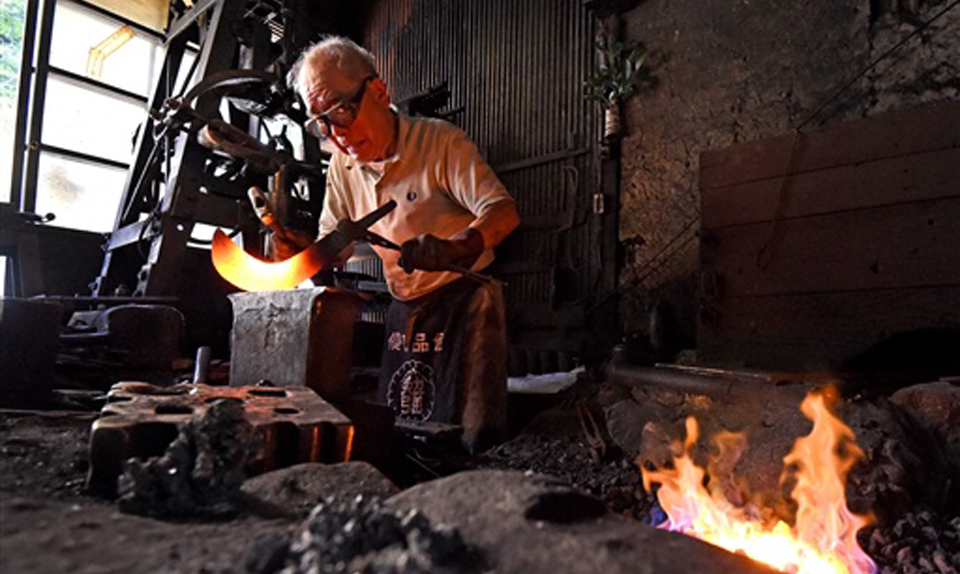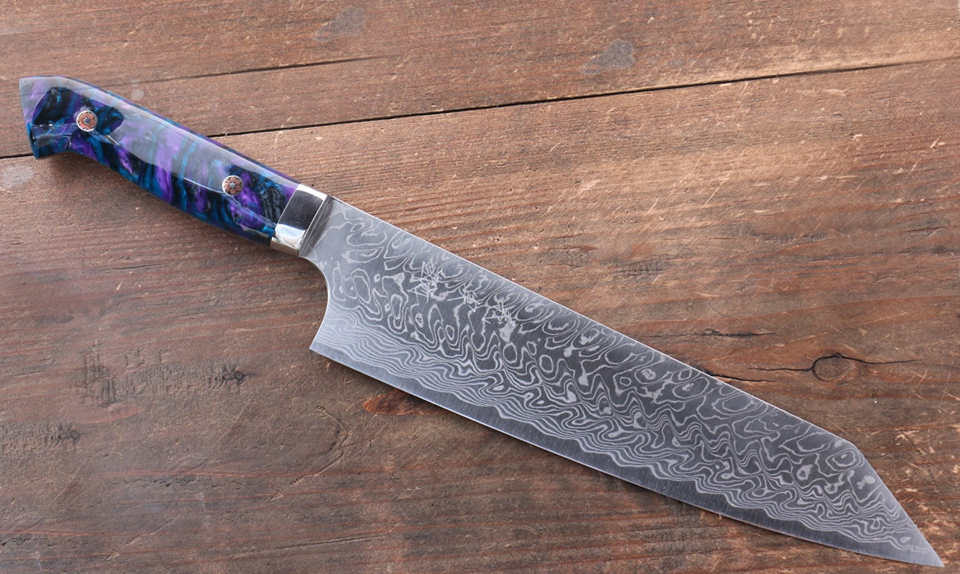Have you ever noticed the mysterious wave-like patterns on steel or knife blades? The true identity behind those patterns is a type of metal known as Damascus steel (also called Wootz steel), a material with an incredibly unique and storied history. This time, HAMONO will explore with you the origins of Damascus steel (Wootz steel) and what makes it so special!
What are Damascus Steel and Wootz Steel?
Have you ever heard of the terms Damascus steel and Wootz steel?

Gamers may have seen or heard of it, as it's often used in the names of weapons or items in games. But is it just a fictional creation by developers? The answer is no! Damascus steel, or Wootz steel, is a real type of metal. Those who work with knives or swords may have seen or even used it in real life.
Although they have different names, they are essentially the same. Wootz steel is, in fact, the original form of what we now call Damascus steel.
In reality, a material known as Wootz steel existed in the ancient world, and the term “Damascus steel” refers to the steel that was later reproduced from this original. Wootz steel was an ancient high-carbon steel first produced in ancient India, with a rich and long-standing history.
What is Wootz Steel?
Wootz steel was developed and produced in India, and it is a metal that dates back to ancient times—before the Common Era. Because it is such an old and rare material, its exact age remains uncertain, though it is believed to have originated around the 6th century BCE.
It is a mysterious metal, with no precisely recorded date of invention. Wootz steel was used as a material for knives and swords, valued for its strength and sharpness. Additionally, due to its exceptional durability, it was also used in crafting various tools and instruments.

Wootz steel possesses not only a mysterious history but also a visually striking feature—the unique surface patterns that appear on the metal. These characteristic wavy lines or grain patterns vary depending on the forging and smelting techniques used. This distinctive appearance is considered the most iconic trait of Wootz steel.
Legend has it that swords made from Wootz steel became sharper the more they were used. While this may sound unscientific or contrary to physical logic, one explanation suggests that: as the blade is used repeatedly, microscopic iron particles embedded in the edge gradually fall away. This natural wearing process is said to form ultra-fine serrations along the edge—so small that they are invisible to the naked eye—potentially making the blade even sharper over time.
This, of course, is part of the lore passed down through generations. The true nature of this effect remains unverified, as the original methods of producing Wootz steel were lost centuries ago.
Does Wootz Steel Rust?
Did you know about the rust-resistant iron pillar at the UNESCO World Heritage Site Qutub Minar, located on the outskirts of Delhi, India? This remarkable structure is known as the Iron Pillar of Delhi, and it is believed to have been erected around 415 CE (not BCE).

This iron pillar has remained rust-free for about 1,600 years, and the metal it’s made from is believed to be Wootz steel.
Wootz steel is thought to be rust-resistant due to its unique manufacturing process. In particular, it is considered a rare metal free from rust-prone impurities, and it possesses strong, durable properties. For example, gold and silver generally exist in nearly pure forms.
Gold and silver are non-ferrous metals, so while they are not particularly strong, they do not rust like other metals. Similarly, since Wootz steel is believed to be the only type of iron made from pure iron ore, it is thought to have properties similar to those of gold and silver.
However, even in the modern age, no form of iron is completely rustproof. It is said that even 99.72% pure iron will begin to rust within 50 years. So how exactly is Wootz steel resistant to rust?
Wootz Steel Production Method
Wootz steel is a forged metal known for its beautiful surface patterns, but in reality, the method for producing Wootz steel has been lost for centuries. One of the reasons it can no longer be manufactured is because the iron ore containing vanadium, once sourced from India, is no longer available.

There are many traditional products that can no longer be made due to the lack of specific regional materials, and Wootz steel is considered one of them. It is truly unfortunate that we can no longer reproduce such a beautiful and durable metal.
Reproducing Wootz Steel
In order to preserve such a beautiful material as Wootz steel, people have been attempting to recreate and revive it for a long time. However, even today, materials scientists and blade makers are still striving to reproduce Wootz steel, yet have not achieved the desired results.

Therefore, it is currently impossible to produce swords or knives made from true Wootz steel in the modern era. Hopefully, in the future, it may be reproduced once again as science and technology continue to advance.
What is Damascus Steel?

The attempt to recreate Wootz steel was unsuccessful, but we were able to produce a similar type and named it Damascus. Keep in mind that modern Damascus steel is another name for Wootz steel. Modern Damascus is made by layering thin sheets of steel and folding them many times to create patterns that imitate Wootz steel. Damascus steel is often used to refer to layered steel.
Does Damascus Steel Rust?
In the past, Wootz steel was considered a rust-resistant metal—but does modern Damascus steel also resist rust? When it comes to rust-resistant metals, stainless steel is often seen as the most impressive. However, in reality, no metal is completely rust-proof, not even stainless steel.

Strictly speaking, rust is a condition in which iron and oxygen combine. When oxygen and iron in the air react slowly, iron-containing metals gradually rust. Stainless steel is less prone to oxidation than iron, so it rusts less easily.
Modern Damascus steel is made by combining metals such as iron and stainless steel, and depending on the materials used, it may be more or less resistant to rust. In theory, Damascus steel made with stainless materials should not rust. However, in reality, even metals labeled as “stainless” can still rust over time.
Therefore, Damascus steel can still rust if it is not properly maintained.
What is happening with Damascus steel now?
Modern Damascus steel is a type of steel made by layering and forging together different metals. Damascus steel is used as a high-grade material for knives and swords due to its hardness and sharpness. It features patterns similar to Wootz steel and has a beautiful, eye-catching appearance.

Damascus steel is considered the perfect version of Wootz steel, even though the method of making it is completely different. Today, it is not only used in knives and swords but also widely applied in other fields such as accessories and Zippo lighters.
Damascus Steel Production Method
Damascus steel is made by stacking layers of different metal sheets and forging them together. Some types are made by twisting bundles of metal into a wire-like shape—this type is called wire Damascus. It is considered a special variation of Damascus steel.

There are many types of modern Damascus steel, as the pattern and hardness vary depending on the materials used. In particular, the pattern changes endlessly depending on the number of metal layers and the forging technique. Therefore, each manufacturer may have their own unique production methods.
Damascus Steel and Japanese Swords
In fact, Damascus steel shares common features with Japanese swords. Japanese swords captivate with the beauty of their blades, excellent hardness, sharpness, and subtle patterns on the blade. Although the patterns are nearly invisible to the naked eye, they resemble those of Wootz steel—the origin of Damascus steel.

Japanese swords are forged using traditional Japanese steels combined with secret hand-forging techniques, resulting in extremely sharp blades. Naturally, swords and knives made from Damascus steel are also hard and possess excellent sharpness.
How to make a Japanese sword similar to Damascus steel?
Both Damascus steel and Japanese swords share the common feature of being created through forging. Folding forging is a unique technique specific to Japanese swords. The steel is repeatedly bent and stretched during forging to enhance its hardness and sharpness. The hardness and sharpness of Japanese swords cannot be achieved without this method.
Japanese swords are forged from hundreds of layers of metal by folding to create the blade, and they also exhibit metal grain patterns similar to Damascus steel.
Different Types of Damascus Steel
Nowadays, there are many styles of Damascus steel. Basically, it is made by forging a mixture of multiple metals at once. However, in recent years, there have been many changes in designs due to an increase in the number of forged metals and improvements in production technology. Some Damascus steel patterns have specific shapes and are given names.
Damascus steel is used not only by knife smiths but also by accessory manufacturers. However, Damascus steel is very complex to make, requiring a lot of effort in production, which significantly increases the cost even in small quantities.
Colored Damascus steel is created by mixing with brass to enhance its appearance, produced using a new manufacturing method. Colored Damascus steel features a blend of yellow and red as well as white and black colors. It becomes softer and is commonly used for accessories, though occasionally it is also used for making knives.

Twisted Damascus steel is characterized by swirling and twisted patterns. It resembles the patterns of soap bubbles and is commonly used in the production of knives and Zippo lighters. Changing the number of steel layers alters the pattern shapes, resulting in many variations.

Rose Damascus steel is characterized by patterns of varying large and small circular shapes. By forging with a rounded hammer to create evenly spaced indentations on the stacked metal sheets, this pattern is achieved. Even small items made from this steel stand out because of its unique circular patterns. Therefore, it is often used in the production of accessories.

Step-pattern Damascus steel features patterns resembling stacked ladders, interspersed with small and large circular shapes. Its production is quite complex, making it suitable for crafting jewelry accessories as well as kitchen knives.

Wave-pattern Damascus steel has surface patterns resembling water ripples. It is a popular style that evokes the original feel of Wootz steel. Wave-pattern Damascus is favored for knife production due to its aesthetic appeal and easier manufacturing compared to other types.

Wire Damascus steel has a slightly different production method compared to other types of Damascus steel. It is created by twisting several to dozens of straight steel rods together while heating. Due to the complexity of this process, products made from this type of steel are highly valued and more expensive than other Damascus steels.

Damascus Steel Knives
Knives made from Damascus steel are widely loved not only for their appearance but also for the many excellent properties they offer. Knives crafted from Damascus steel have a hardness that is carefully balanced, giving the blade sharpness while resisting wear and tear.

Depending on the type of Damascus steel produced, hardness and sharpness can vary as desired. Sharpness is the most important factor for knives and cutting tools, but edge retention and the ability to be resharpened are equally important. These qualities are determined by the type of steel that makes up the knife.
So, we’ve learned quite a lot about Damascus steel through this article. If you want to own a knife made from Damascus steel, be sure to visit HAMONO!